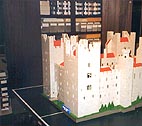 |
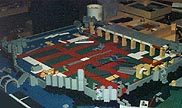 |
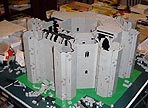 |
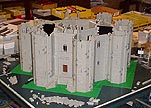 |
| Freezer
bins and old drug sample containers |
Lego boxes
with dividers & a pipe tobacco container |
Myriad
containers of all sizes... |
...stacked
in cabinets & an old wardrobe! |
Storing
My LegoŽ Bricks
A problem for all of you with LOTS of blocks!
This is NOT an
official Lego site
| 1.
Tiring of your old system? Like many of
you, storing and finding your Lego bricks gets to be an
increasing problem as your collection grows. While I did
not take "before" pictures of my "mess"
in the rec room, I have located several old pictures that
show some of the clutter and the array of different
containers I used to store bricks in. Projects were
occasionally delayed while I searched through box after
box and cannister after cannister, looking for a part!
The old green Sears pingpong table was sagging from age
and the weight of increasingly large castles, making
building more problematic. Something had to give. |
 |
 |
 |
 |
| Freezer
bins and old drug sample containers |
Lego boxes
with dividers & a pipe tobacco container |
Myriad
containers of all sizes... |
...stacked
in cabinets & an old wardrobe! |
| 2.
Then the time finally came to redo the basement. Seredipitously,
our 26 year old basement was due to be redone. My wife
Judy said "Since you persist in spending much of
your spare time in the basement building your castles,
why don't we redecorate with your hobby in mind."
Needless to say, I was both flabbergasted and delighted
with the opportunity. I immediately began the redesign,
with the computer to be moved from the playroom to the
larger rec room. Boxes and stacks of plans and hundreds
of photographs would need filing space. |
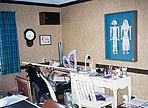 |
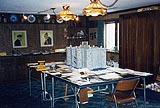 |
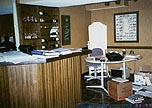 |
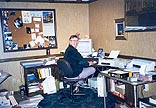 |
| The
basement rec room with years of junk. |
The
sagging pingpong table and cabinetry. |
The
playroom with bar and old kitchen table. |
Yours
truly in the playroom "computer corner". |
| 3.
Out with the old...and in with the new! We
pretty much wiped the slate clean, not only in the
recreation room, but in the playroom, laundry/sewing room
and 1/2 bath as well. The dark oak cabinets and shelves,
with its fold-down slot car track was torn out. Out went
the carpet (which was dark and hard to see Lego bricks on),
wallpaper, wainscoating, etc. Two Tiffany hanging lamps
were replaced by three fluorescent "clouds".
The oak bar was covered in 15" square Lego bases,
for continuity as well as Lego art possibilities. |
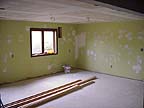 |
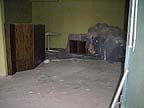 |
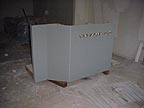 |
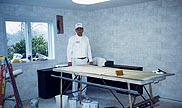 |
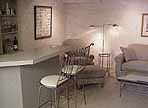 |
| The
Recreation Room was gutted & readied. |
So was the
Playroom. |
A welcome
in Lego for our painter, Dave. |
Dave, the
painter, also wallpapers. |
Everythings
finally in place. |
| 4.
And how will I store my Legos? The big
problem was what to do with what I guessed were several
hundred thousand Lego bricks. I made requests on Lugnet
and rec.toys.lego for storage suggestions -- and received
a considerable number of responses from other Lego lovers,
including a picture taken at the MIT Media Lab [see right],
showing stacks of clear plastic storage bins! I went out
on the internet looking for such units and soon came
across Quantum Storage Systems in Miami, Florida [http://www.quantumstorage.com/quantum/tob5.htm].
Their tip-out bin units were 24" long and came in
various sizes. They recommended a Double Slider Frame to
be mounted on a Gondola made by Lozier Corporation [http://www.lozier.com/products_frames.htm].
They recommended a dealer in nearby Pekin, Illinois, and
then it was a matter of ordering and waiting anxiously
for everything to arrive. |
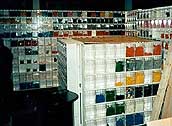 |
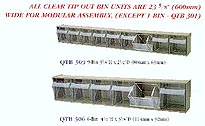 |
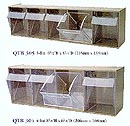 |
 |
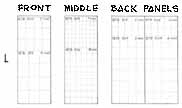 |
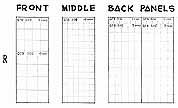 |
| QTB 309
& 306 for small parts. |
QTB 305
& 304 for larger volumes. |
QTB303 for huge volumes. |
The left
system containes 210 bins, including the 309's. |
The right
system was close at 209 bins! |
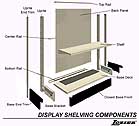 |
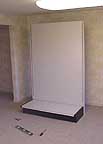 |
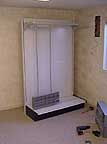 |
 |
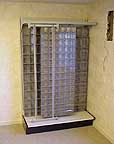 |
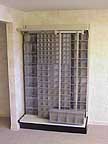 |
| Lozier
Gondola components. |
Lozier
Gondola assembled. |
Slider
frame added and tested. |
Bin units
are added to the back panels. |
Middle
sliders are filled with bins. |
Front
slider bins are bolted in place. |
| 7.
And everything just came together. Finally,
the storage system assembled, the Legos are brought out
of storage and the new Quantum units are filled! What fun.
Some old Lego boxes are retained for plates, bases,
horses and other parts not suitable for bins. Finally the
ponderous 3" thick table I had made arrives, 88"
long and 58" wide, with two leaves. Bookcases are
built around the computer corner for books, castle
guidebooks, notebooks, CD-ROMs, etc. Now its time to
start designing and building castles again!! |
Return to the
main castle
page.
Castles created by
Robert
Carney
Page designed & maintained by Robert Carney